Mt. Koya (Koyasan) guide
![]()
![]()
Okunoin and Danjo Garan are considered the
most sacred areas of Koyasan.
The name Garan is derived from Sanskrit,
and means a quiet and secluded place where Buddhist monks may train.
The Garan is where Kobo Daishi actually
began construction himself in the early years of Koyasan’s history.
In 819 the guards, Niutsuhime and
Karibamyojin were enshrined here.
In addition the construction of Great
Stupa, the golden hall and many other buildings had begun during Kobo Daish’s lifetime.
The path leading to the Danjo Garan from
the east is illuminated at night, and in autumn the maple leaves here are
beautiful.

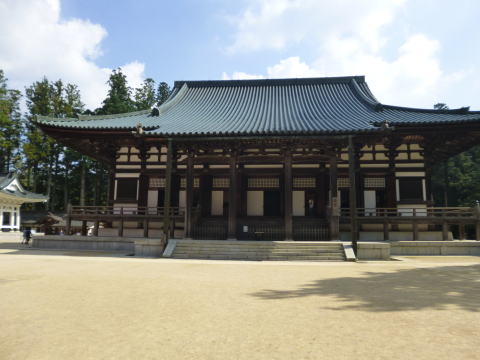
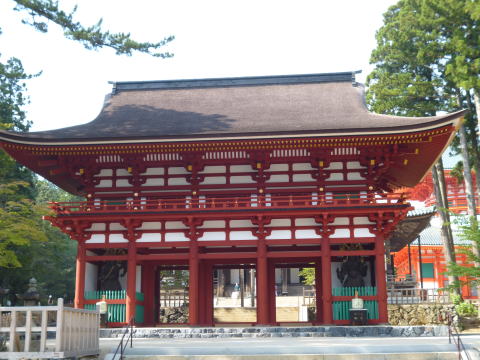
Konpon Daito (Great Fundamental Pagoda) ![]()
The Konpon Daito is the tallest building in Koyasan.
After Kobo Daishi Kukai was granted the use of Koyasan by Emperor Saga in 816, he decided to build the first monastic complex entirely dedicated to the teaching and practice of Esoteric Buddhism.
He planned to construct two large two-storied pagodas diagonally behind
the Kondo in the eastern and western directions.
Plans called for the Konpon Daito to be about 48.5m high, and because of its great size it was finally completed around 876, over 40 years after Kobo Daishi entered into eternal meditation.
In later centuries the Konpon Daito was destroyed in fires caused by lightning
strikes five times, and rebuilt each time.
After the great fire of 1843, only the foundation stones remained. The existing building was rebuilt in 1937.
Architecturally, the Konpon Daito is classified as an early form of the
two-storied pagoda.
The body of the pagoda is circular, with a square lower storey with and
attached pent roof and walls.
The majestic Konpon Daito is today exactly as it was when it was first
constructed, and is known as a symbol of Koyasan (Mt. Koya).
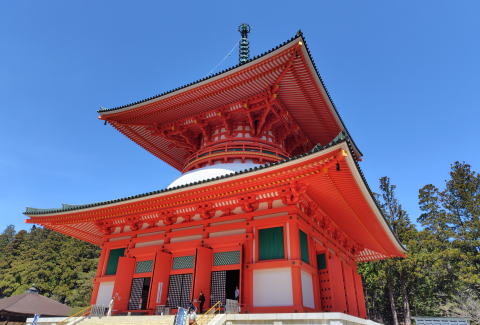
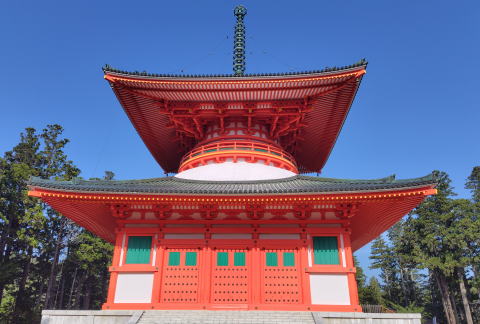

"Shinbutsu-shūgō" refers to the syncretism of Buddhism and Shinto
in Japan.
Shinbutsu-shūgō (Syncretism of Kami and
Buddhas)
In Japan, there is a unique blend of
Buddhism and Shinto called "Shinbutsu-shūgō." This term means the
combination or amalgamation of Shinto and Buddhist beliefs and practices.
Shinto, the indigenous spirituality of
Japan, focuses on the worship of kami (spirits or gods) associated with nature
and ancestors. Buddhism, which came to Japan from China and Korea in the 6th
century, brought new teachings, rituals, and deities.
Over time, the two religions began to
influence each other. Temples and shrines were built together, and many people
started to worship both kami and Buddhas. Shinto gods were sometimes seen as
manifestations of Buddhist deities and vice versa. This fusion created a unique
religious landscape in Japan, where both traditions coexist and are often
practiced together.
This blending continued until the Meiji
period (1868-1912), when the government sought to separate Shinto and Buddhism
to promote Shinto as the state religion. Despite this separation, the influence
of Shinbutsu-shūgō remains evident in Japanese culture and religious practices
today.
The differences between Buddhism and Esoteric Buddhism (Mikkyo) :
Buddhism, founded by Siddhartha Gautama (the Buddha) in the 5th century BCE in India, focuses on the following core teachings and practices:
Esoteric Buddhism, particularly prominent in the Shingon and Tendai sects in Japan, incorporates more secretive and ritualistic elements. Key aspects include:
Transmission of Teachings:
Rituals and Practices:
Approach to Enlightenment:
Concept of Enlightenment:
In summary, while both Buddhism and Esoteric Buddhism share the same foundational
goals of achieving enlightenment and liberation from suffering, Esoteric
Buddhism incorporates more elaborate rituals, secretive teachings, and
a focus on achieving enlightenment in the present life through specific,
symbolic practices.
The Taizokai Mandala and the Kongokai Mandala of Shingon Buddhism:
The Taizokai Mandala, also known as the Womb World Mandala, represents the physical world and the cosmos from the perspective of compassion and enlightenment. It is associated with the principle of "Dainichi Nyorai" (Mahavairocana Buddha), who embodies the universal truth. This mandala is divided into multiple sections, each containing various deities and bodhisattvas, symbolizing different aspects of spiritual wisdom and compassion. The central figure is Dainichi Nyorai, surrounded by other enlightened beings, illustrating the interconnectedness of all things and the potential for all beings to achieve enlightenment.
The Kongokai Mandala, also known as the Diamond World Mandala, represents the spiritual and indestructible nature of enlightenment. It emphasizes the power and wisdom needed to achieve enlightenment. The central figure in this mandala is also Dainichi Nyorai, but in this context, he represents the unchanging, eternal truth. The mandala is arranged in a highly symmetrical and geometric pattern, symbolizing the clarity and precision of the enlightened mind. The deities in this mandala are associated with different forms of wisdom and power, reflecting the path of rigorous practice and insight.
Both mandalas are used in Shingon Buddhism to aid meditation and visualization practices. Practitioners focus on the detailed images and symbolism within the mandalas to deepen their understanding of Buddhist teachings and to progress on their path to enlightenment. These mandalas serve as maps of the spiritual universe, guiding practitioners through different stages of spiritual development.
In summary:
Both mandalas complement each other, offering a comprehensive framework for understanding and achieving enlightenment in Shingon Buddhism.
![]()
![]()
Just as Kobo Daishi was departing from Tang China to return to Japan in
806,
he is said to have thrown a three-pointed vajra, a Shingon Buddhist ritual
item, toward Japan from the port of Mingzhou
with the wish of finding a place appropriate for establishing Shingon Buddism
in Japan.
After returning to Japan he serched for the study center of the Shingon Buddhism.
He came to Koyasan and found the three pointed vajra lodged in the pine
tree.
Since then, the pine tree has been called the Sanko no Matsu, or the three-pointed
Vajra Pine Tree,
and is popularly connected with faith in Kobo Daishi.
Pine needles usually come in clusters ranging from two to five needles,
the needles of Sanko no Matsu however, are in clusters of three, like the
three-pointed vajra it is named after.
Visitors today treat needles of Sanko no Matsu as talismans and keep them
as lucky charms.


![]()
Kongobuji is located at Koyasan in Wakayama prefecture.
Kongobuji is the administrative head temple of Koyasan Shingon Buddhism.
The temple was founded in 816 by Kukai.
Originally the entire area of Koyasan was known as Kogobuji and there was
no specific building by that name.
In 1593, Hideyoshi TOYOTOMI built Seiganji temple and Mokujiki OGO built
Kozanji temple next to Seiganji temple.
The building now called Kongobuji was combined in 1869 from those two temples.
The temple contains beautiful screen paintings and Japan's largest rock
garden, the Banryutei.
From Koyasan station of the Nankai Koya line, it takes about 10 minutes
to Konobuji bus stop.
In front of the temple, there is a free parking spot.
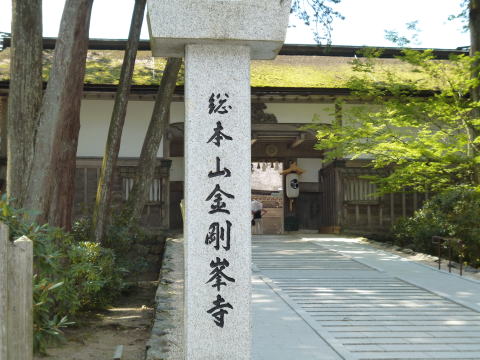
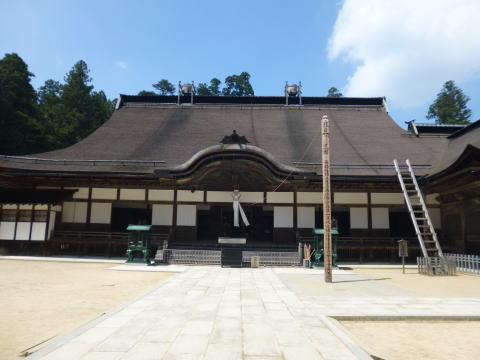

Shojoshin-in ![]()
Shojoshin-in is a special head temple of the Shingon sect, located on the
west side of Ichinohashi Bridge at the entrance to Okunoin, Mount Koya,
Wakayama Prefecture.
The principal image is a statue of Kobo Daishi, which is said to have been carved by Kukai (Kobo Daishi) himself on March 20, 835, the day before his death, with the three characters "Miunkan" written on the back of the statue.
From this, it is called "Twenty Days of the Great Master" and
is currently a secret Buddha.
Every year, on the principal image's festival day (currently April 20),
it is opened to the public and a grand memorial service is held.
Founded by Kukai during the Tencho era (824-833), it was originally called
Kitabo, but was renamed Shojoshin-in by imperial decree, and later, Taira
no Kiyomori's son Munemori rebuilt the temple.
The Tale of the Heike, Volume 10, states that Takiguchi Nyudo, who had
retired to Saga Ojo-in Temple as a monk, climbed Mount Koya to break his
attachment to the flute and lived in the temple.
During the Warring States period(16th century), the temple became a place
of prayer for Uesugi Kenshin, and houses many letters written by Kenshin
and Uesugi Kagekatsu. The temple also manages the Uesugi Kenshin Mausoleum
(a nationally designated Important Cultural Property) in Okunoin semetary.
Satake Yoshishige also performed a memorial service here, and letters from
Satake Yoshiaki and Yoshinori are also in the collection.
Within the grounds is a famous umbrella cherry tree, where Toyotomi Hideyoshi is said to have held a cherry blossom viewing.
Goma prayers are held every day in the goma hall.

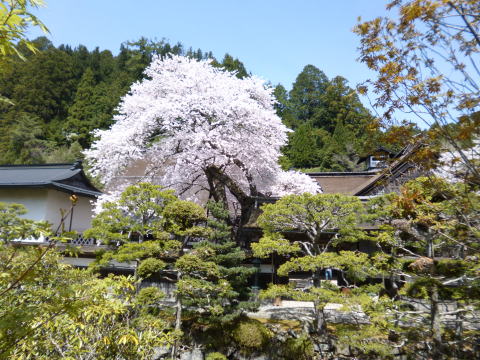

Goma Fire Ritual at Koyasan Temples
The Goma Fire Ritual is a sacred ceremony in Japanese esoteric Buddhism, especially practiced in temples at Koyasan.
It is a powerful prayer ritual aimed at purification, protection, and the
fulfillment of wishes.
During the ceremony, wooden sticks called Gomaki (護摩木) are used to symbolize people's desires, prayers,
or problems.
These wooden sticks are written on by participants with their wishes or
concerns.
The temple's priest then places the Gomaki into the sacred fire, which
is believed to transform these wishes into spiritual energy that reaches
the deities. The fire represents the wisdom of the Buddha, burning away
negative karma and obstacles, and purifying the mind and body.
The Goma ritual is accompanied by chanting and the rhythmic sound of drums, creating a deeply spiritual atmosphere.
It’s a unique and moving experience, open to anyone seeking blessings for themselves or their loved ones.
Many temples in Koyasan offer the Goma ritual, and visitors can participate
by offering their own Gomaki for the ceremony.
![]()
Okunoin is a cemetery and sacred area that extends about 2km from the Ichinohashi bridge to Kobo Daishi's mausoleum.
The path is lined on both sides by hundreds of centuries-old towering cedar
trees.
Among the trees are over 200,000 gravestones and memorial pagodas for people
ranging from important figures to commoners.
In the prayer for the Manto-Mange-e ceremony in 832, Kobo Daishi wrote, "When the universe,
all living beings, and nirvana are exhausted, my wish then be fulfilled."
In other words, he made a great vow:
"As long as all living beings in the universe try to attain enlightenment,
as long as they try to become Buddas, as long as people keep seeking nirvana,
I will not finish my prayers.
There is writen stone sign of his vow on the left side of the path.
Every year on August 13th, Candle Festival (Rosoku Matsuri) is held on
the path.
100,000 candles are lit along the path in the precincts of Okunoin from
the Ichinohashi bridge to the Torodo (Lantern Hall).
From 8:00pm, a Buddhist memorial ceremony is held at the Torodo.
The best way to approach Okunoin is to take the bus from Koyasan station
to Ichinohashimaebus stop.
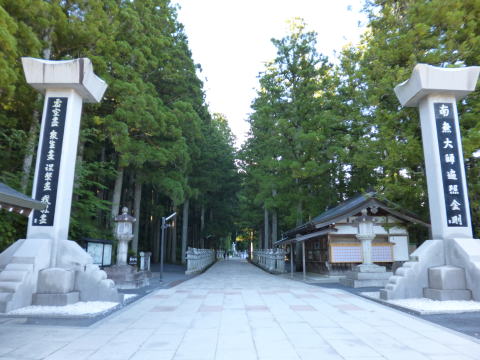


The Okunoin Gokusho (the offering hall) ![]()
![]()
The Okunoin Gokusho (the offering hall) is located in Mount Koya in Wakayama
Prefecture.
It is said to have started as a small hermitage built to serve the mausoleum
of Kukai (Kobo Daishi).
Even today, daily offerings to Kobo Daishi are made at the Gokusho and
are carried to the tomb by priests twice a day, at 6am and 10:30am.
To the north of the Gokusho is the Ajimi Jizo.
It is said that these Jizo were originally Aiman and Aigo, two disciples who took care of Kobo Daishi's meals, and were enshrined as Mikuriya Myojin near the Gobyo Bridge.
The food for Kobo Daishi is prepared at the offering hall and placed in
a chest, where it is offered to the Jizo statue by priests called Yuina
and Gyoboushi, and then carried to the Lantern Hall in front of the mausoleum.
This is based on the "Kobo Daishi faith," which believes that
Kukai is still in eternal meditation at the mausoleum, watching over future
generations.
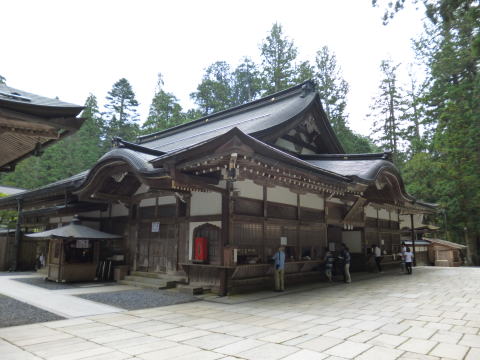

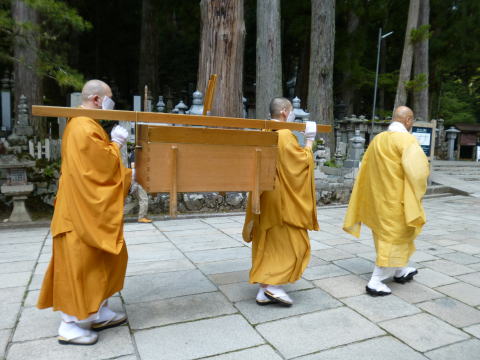
1 Major English Web Sites
Kongobuji
A Guide to Koyasan
Koya Tourism Association
2 Access Information by train and bus
Koyasan Access Map by Train
Train and Bus timetable from Osaka to Koyasan (weekday)
Train and Bus timetable from Osaka to Koyasan (Holiday)
Bus and Train timetable from Koyasan to Osaka (weekday)
Bus and Train timetable from Koyasan to Osaka (Holiday)
Bus service to Kumano
Access to Kyoto Shinkansen Kumanohongu Nara
Nankai Railway
3 Access information by car
Route from Osaka to Koyasan
4 Other Web Sites
Koyasan Restaurant Map for Lunch for Dinner
The Official Wakayama Travel Guide
BBC travel Wakayama prefecture
Kansai scene
Japan the Official Guide
Kansai finder
Deep Experience
Kisho-horai
Japan Visitor Hotline 050-3816-2787
TOP PAGE 観光カレンダー
TOP PAGE 观光最佳时期